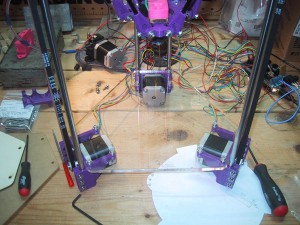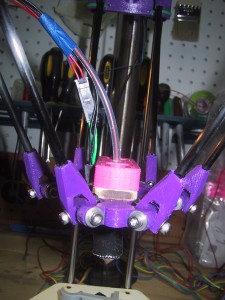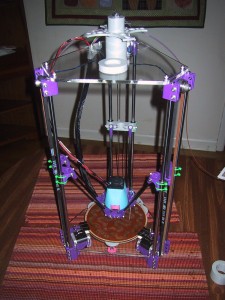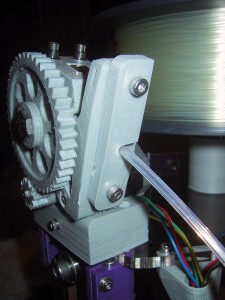When calibrating the bed of a standard 3D printer, you can slide a piece of paper under the extruder and adjust the bed until it’s touching the extruder (but still able to be pulled out) in several places to level the bed about right. However, with a delta bot, your X/Y/Z coordinate system must be converted mathematically into the coordinate system of the three carriages ridding the towers, and determining if your calibration parameters are correct is not as easy. If your calibration parameters are incorrect, your entire coordinate space may be warped!
I was able to eyeball things to get my calibration parameters set up “good enough” for standard use, but it still wasn’t perfect. I finally broke down and shelled out $15 for a cheap Chinese made machinist’s dial indicator so that I could get my coordinate space transforms square and flat down to a thousandths of an inch. (I changed one calibration parameter by 0.5 mm…so it wasn’t terribly far off from the “eyeball” approach, but I feel better about it now…)
Here is a video of the machinist’s dial indicator in action:
The nine small vertical “bumps” in the beginning of the video is from me pushing the 0.1mm down button on the control interface multiple times until I got the indicator close to the top of the dial. As you can see from the dial it takes nine 0.1mm bumps to travel around 3.5 hundredths of an inch. Google says that 0.9mm = 0.0354331 inches, so my units appear to line up right.
I also jumped the head up and down 10mm at a time to show that the head comes back to the same Z height.
When I scrape the probe back and forth in the Y axis the indicator jiggles around due to friction, but you can see that the measurements don’t move more than 0.01″ when the probe moved across the entire glass build plate (and it’s very close to 0.001″ accuracy when stopped at the end and middle points). Overall I’m very happy with the positional accuracy and calibration of the motion platform now. Although I only measured the Z axis with my dial indicator, because it’s a delta-bot the z-axis is a joint effort of all three towers, so I figure that my positioning accuracy in the Z coordinate axis is a good proxy for the X and Y coordinate axis as well.



